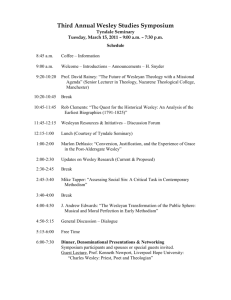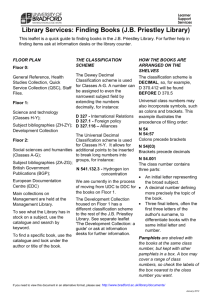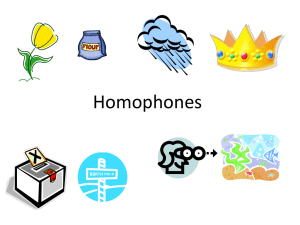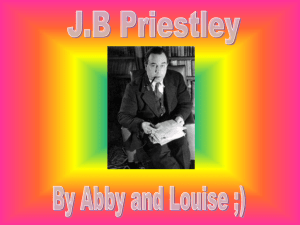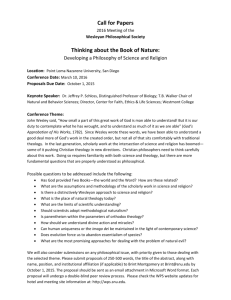The responses of Priestly, Wesley and Faraday
advertisement
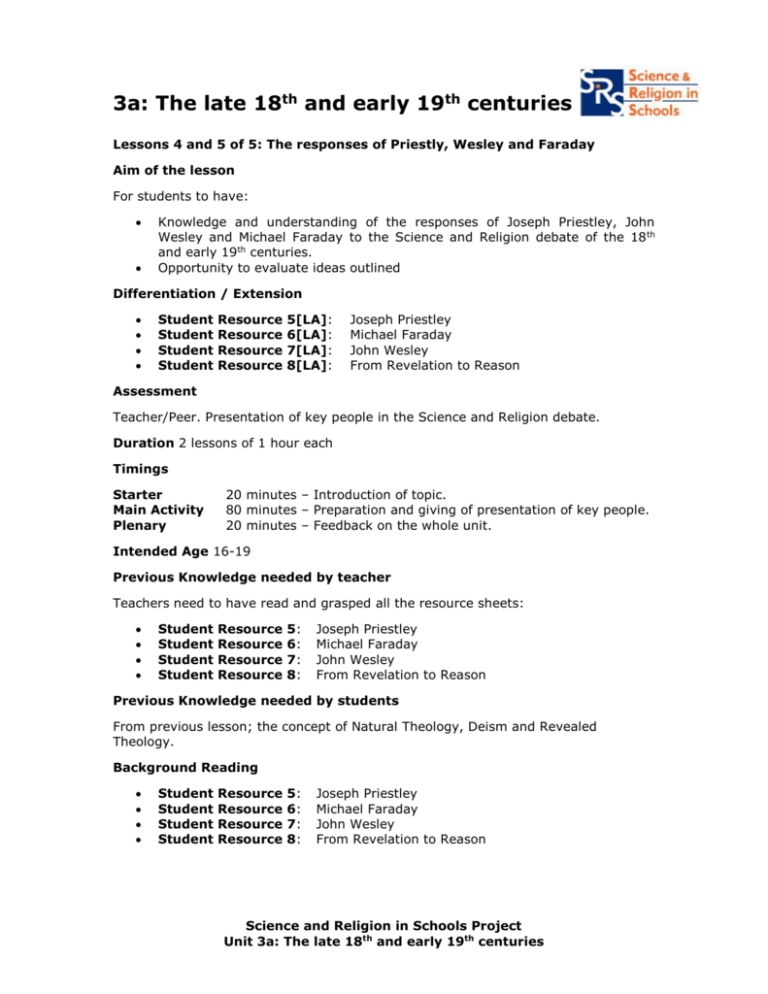
3a: The late 18th and early 19th centuries Lessons 4 and 5 of 5: The responses of Priestly, Wesley and Faraday Aim of the lesson For students to have: Knowledge and understanding of the responses of Joseph Priestley, John Wesley and Michael Faraday to the Science and Religion debate of the 18 th and early 19th centuries. Opportunity to evaluate ideas outlined Differentiation / Extension Student Student Student Student Resource Resource Resource Resource 5[LA]: 6[LA]: 7[LA]: 8[LA]: Joseph Priestley Michael Faraday John Wesley From Revelation to Reason Assessment Teacher/Peer. Presentation of key people in the Science and Religion debate. Duration 2 lessons of 1 hour each Timings Starter Main Activity Plenary 20 minutes – Introduction of topic. 80 minutes – Preparation and giving of presentation of key people. 20 minutes – Feedback on the whole unit. Intended Age 16-19 Previous Knowledge needed by teacher Teachers need to have read and grasped all the resource sheets: Student Student Student Student Resource Resource Resource Resource 5: 6: 7: 8: Joseph Priestley Michael Faraday John Wesley From Revelation to Reason Previous Knowledge needed by students From previous lesson; the concept of Natural Theology, Deism and Revealed Theology. Background Reading Student Student Student Student Resource Resource Resource Resource 5: 6: 7: 8: Joseph Priestley Michael Faraday John Wesley From Revelation to Reason Science and Religion in Schools Project Unit 3a: The late 18th and early 19th centuries Resources Student Student Student Student Student Student Student Student Resource Resource Resource Resource Resource Resource Resource Resource 5: 5[LA]: 6: 6[LA]: 7: 7[LA]: 8: 8[LA]: Joseph Priestley Joseph Priestley Michael Faraday Michael Faraday John Wesley John Wesley From Revelation to Reason From Revelation to Reason Further resources: World Book Multimedia Encyclopaedia, 2004 A Beginner’s Guide to Ideas, Raeper and Smith, Lion Publisher. Ch. 1. The Philosophy Files, Stephen Law, Dolphin. The Simpsons and Philosophy; Irwin, Conard, Skoble; Open Court. Pooh and the Philosophers; J Tyerman Williams; Methuen Publisher. Philosophy of Religion for A level, A Jordan et al., Stanley Thornes http://www.asa3.org/ASA/PSCF/1991/PSCF12-91Miles.html http://oldsite.library.upenn.edu/etext/collections/science/priestley/about. html http://www.spartacus.schoolnet.co.uk/PRpriestley.htm http://www1.umn.edu/ships/religion/faraday.htm Science and Religion in Schools Project Unit 3a: The late 18th and early 19th centuries Introduction / Starter activity Recap the concepts of Natural Theology and Deism and how such ideas were in conflict with Revealed Theology and miracles as interventions of God (violations of the natural order; see David Hume). Introduce this lesson’s topic by presenting the students with a kitchen appliance (eg. a mixer); an oxygen mask (the science department might have one or something equivalent to do with oxygen) and a Methodist Prayer book. Open a discussion about the relevance of these everyday things to the Religion and Science debate (Joseph Priestley discovered oxygen – the mask; Michael Faraday discovered electromagnetism – the mixer; John Wesley founded Methodism – prayer book. All three made very important contributions to the debate and relation between Religion and Science). Introduce further by giving a brief overview of the changing challenges in the Science and Religion debate of the 18 th/19th centuries (see Student Resource 8: From Revelation to Reason): New scientific experiments (theories of the atom and of matter; the hydra and epigenic theories) and influence from the French philosophes challenged Revealed Theology as well as Natural Theology and Deism and gave rise to Materialism and Atheism. Ideas of passive and contingent matter were replaced with a more dynamic and self-contained view of matter and nature which challenged the necessity of a God as a first cause. Beliefs in an immaterial soul which stems from an immaterial God were challenged by a more materialistic view of personhood and the natural world. The loss of academic authority of the scriptures; they remained relevant for spiritual and devotional purposes as the books of ‘personal salvation’. Christians responded in different ways to those challenges: mainstream Churches and Christians tended to accept the data from the experiments but rejected their philosophical and theological interpretation (eg. a selfcontained natural world without the need for God; materialistic views of personhood without an immaterial soul; scripture as irrelevant etc.). Other Christian, such as the religious dissenters turned against the mainstream traditions and towards non-conformist denominations or movements. Three of these (Priestley, Faraday and Wesley) will be the main focus of this lesson. Science and Religion in Schools Project Unit 3a: The late 18th and early 19th centuries Main Activities Divide the class into groups of 3 to 4 and handout the worksheets on Joseph Priestley, John Wesley and Michael Faraday (see Student Resources 5, 6 and 7) so that you have some groups working on Priestley, some on Wesley and some on Faraday. Their task is to read the worksheet and study how the person responded to the Science and Religion debate of their time. They should take brief notes on this or highlight the important bits. Secondly they should discuss how convincing they find the response and how they would respond to the challenges. Thirdly they are to present their scientist and their own comments to the rest of the class. Whole class discussion and sum up ideas. Alternatively you could use the ICT resources from below and let the student do some further research on Priestley, Faraday and Wesley and prepare for a computerised preparation using PowerPoint and/or an Interactive Whiteboard. Plenary Feedback on the unit: What have we learnt from the 18th/19th century debate? Are Science and Religion reconcilable (Can one be a fully committed Scientist and a fully committed Believer in Religion at the same time?)? How important are Revelation and Reason for Faith? Any other questions and comments. Science and Religion in Schools Project Unit 3a: The late 18th and early 19th centuries
